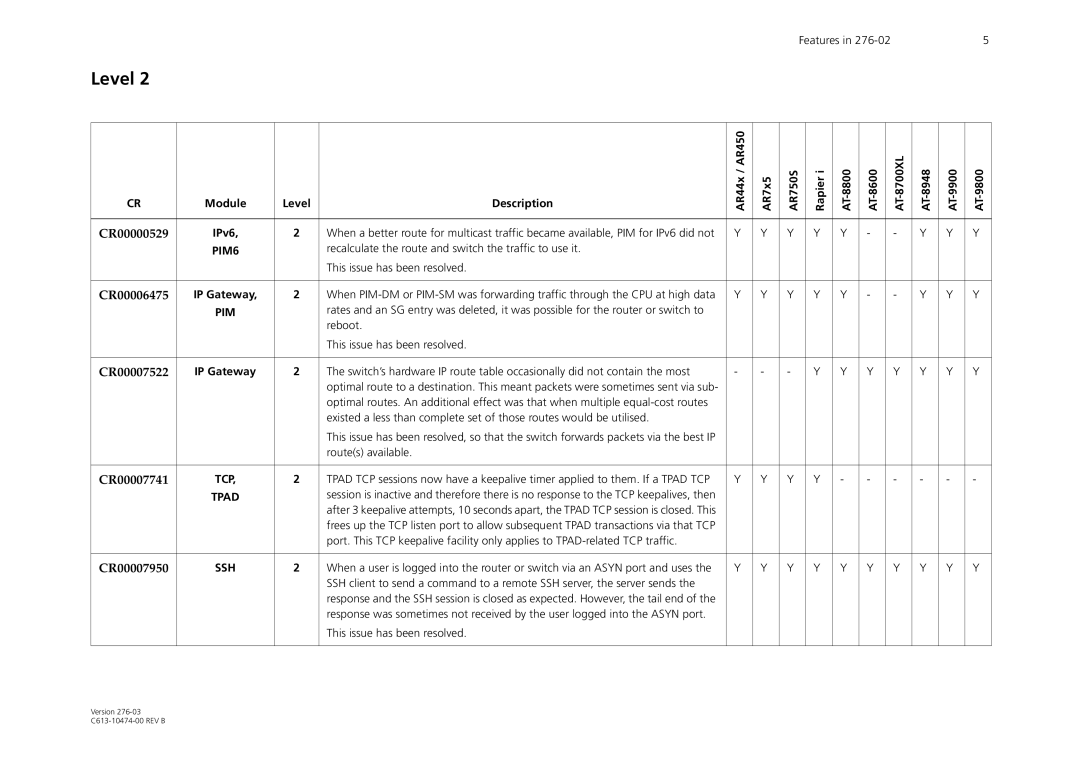Features in | 5 |
Level 2
CR | Module | Level | Description | AR44x / AR450 | AR7x5 | AR750S | Rapier i | ||||||
|
|
|
|
|
|
|
|
|
|
|
|
|
|
CR00000529 | IPv6, | 2 | When a better route for multicast traffic became available, PIM for IPv6 did not | Y | Y | Y | Y | Y | - | - | Y | Y | Y |
| PIM6 |
| recalculate the route and switch the traffic to use it. |
|
|
|
|
|
|
|
|
|
|
|
|
| This issue has been resolved. |
|
|
|
|
|
|
|
|
|
|
|
|
|
|
|
|
|
|
|
|
|
|
|
|
CR00006475 | IP Gateway, | 2 | When | Y | Y | Y | Y | Y | - | - | Y | Y | Y |
| PIM |
| rates and an SG entry was deleted, it was possible for the router or switch to |
|
|
|
|
|
|
|
|
|
|
|
|
| reboot. |
|
|
|
|
|
|
|
|
|
|
|
|
| This issue has been resolved. |
|
|
|
|
|
|
|
|
|
|
|
|
|
|
|
|
|
|
|
|
|
|
|
|
CR00007522 | IP Gateway | 2 | The switch’s hardware IP route table occasionally did not contain the most | - | - | - | Y | Y | Y | Y | Y | Y | Y |
|
|
| optimal route to a destination. This meant packets were sometimes sent via sub- |
|
|
|
|
|
|
|
|
|
|
|
|
| optimal routes. An additional effect was that when multiple |
|
|
|
|
|
|
|
|
|
|
|
|
| existed a less than complete set of those routes would be utilised. |
|
|
|
|
|
|
|
|
|
|
|
|
| This issue has been resolved, so that the switch forwards packets via the best IP |
|
|
|
|
|
|
|
|
|
|
|
|
| route(s) available. |
|
|
|
|
|
|
|
|
|
|
|
|
|
|
|
|
|
|
|
|
|
|
|
|
CR00007741 | TCP, | 2 | TPAD TCP sessions now have a keepalive timer applied to them. If a TPAD TCP | Y | Y | Y | Y | - | - | - | - | - | - |
| TPAD |
| session is inactive and therefore there is no response to the TCP keepalives, then |
|
|
|
|
|
|
|
|
|
|
|
|
| after 3 keepalive attempts, 10 seconds apart, the TPAD TCP session is closed. This |
|
|
|
|
|
|
|
|
|
|
|
|
| frees up the TCP listen port to allow subsequent TPAD transactions via that TCP |
|
|
|
|
|
|
|
|
|
|
|
|
| port. This TCP keepalive facility only applies to |
|
|
|
|
|
|
|
|
|
|
|
|
|
|
|
|
|
|
|
|
|
|
|
|
CR00007950 | SSH | 2 | When a user is logged into the router or switch via an ASYN port and uses the | Y | Y | Y | Y | Y | Y | Y | Y | Y | Y |
|
|
| SSH client to send a command to a remote SSH server, the server sends the |
|
|
|
|
|
|
|
|
|
|
|
|
| response and the SSH session is closed as expected. However, the tail end of the |
|
|
|
|
|
|
|
|
|
|
|
|
| response was sometimes not received by the user logged into the ASYN port. |
|
|
|
|
|
|
|
|
|
|
|
|
| This issue has been resolved. |
|
|
|
|
|
|
|
|
|
|
|
|
|
|
|
|
|
|
|
|
|
|
|
|
Version
